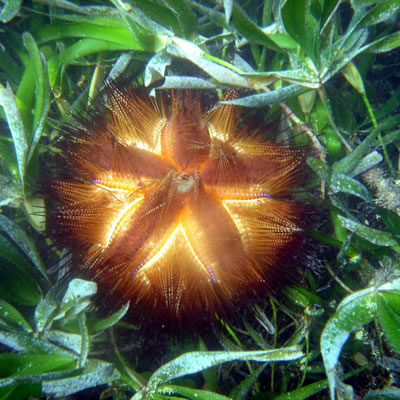Seagrass meadows in “hot water” – IUCN
Seagrass meadows are essential to commercial species such as prawns

Photo: Gabriel Grimsditch, IUCN
Impacts of global change threaten commercially valuable seagrass meadows, according to a report launched today by IUCN, the International Union for Conservation of Nature. One hectare of seagrass meadows is worth around €12,000 per year, by providing benefits like food and shelter for highly valued prawn and fish populations.
The IUCN report Managing Seagrasses for Resilience to Climate Change, analyzes the threats faced by these marine flowering plants and provides survival strategies. Seagrasses are submerged marine flowering plants forming extensive meadows in shallow waters worldwide.
“Overall, seagrasses are in a vulnerable state,” says Mats Björk, one of the authors of the publication. “Seagrass habitats are already declining due to increasing water temperatures, algae growth and light reduction, which are all effects of global change.”
Seagrasses need high light intensities to survive. Storms, flooding and coastal erosion create sediment disturbances that smother the seagrass plants. Excessive nutrients (eutrophication) added to coastal waters may lead to algae invasions that also shade the seagrass leaves. Warmer sea water, changes in ocean acidity and higher CO2 concentrations in the atmosphere also affect seagrasses, but the exact consequences cannot be foreseen yet. When all these global changes come together, already stressed seagrass systems will be pushed over their limit of existence, resulting in further widespread seagrass losses.
“Our oceans’ treasures are under attack from climate change – now is the time to realize the true value of this precious natural resource,” says Carl Gustaf Lundin, Head of IUCN’s Global Marine Programme. “Seagrass provides shelter for many animals, including fish and shellfish, and can also be a direct food source for dugongs, turtles, sea urchins and seabirds.”
Seagrasses also have many traditional uses such as filling for mattresses, traditional medicine against skin diseases in the Mediterranean, and as roof coverings in Europe and Africa.
While many global change effects such as increasing water temperatures are already real, much can be done to help seagrasses survive.
“We need to make seagrass more resilient to global change. For example, we know that genetically more diverse populations of seagrasses have a higher chance of success in a changing environment,” says Lundin . “Protection of seagrass refugia and connecting them to adjacent habitats such as mangroves or coral reefs will increase their survival chances considerably.”
“While promoting new protected areas and restoring seagrass meadows to stem the causes of global change, IUCN also encourages more research into protecting these vital plants from being pushed out of existence.”
In the Mediterranean, three main seagrass species can be found: Posidonia oceanica, endemic to the Mediterranean, Cymodocea nodosa and Zostera spp. The healthiest areas are located north of Africa, in particular Libya and Tunisia, where development and tourism have not yet affected the coast much.
Notes to Editors
The report Managing Seagrasses for Resilience to Climate Change was authored by Mats Björk (Stockholm University, Sweden and University of Dar es Salaam, Tanzania), Fred Short (University of New Hampshire, USA), Elizabeth Mcleod (The Nature Conservancy, USA) and Sven Beer (Tel Aviv University, Israel).
For more information or to set up interviews, please contact:
James Oliver, communications officer, IUCN Global Marine Programme, tel +41 22 999 0301, james. oliver@iucn.org.
Carolin Wahnbaeck, IUCN media relations officer, tel +41 8587593, email carolin.wahnbaeck@iucn.org.
Borjana Pervan, IUCN Global Communications, tel +41 22 999 0251, email borjana.pervan@iucn.org.
To download the report please go to https://www.iucn.org/downloads/report_seagrass_and_climate_change.pdf
Photos







